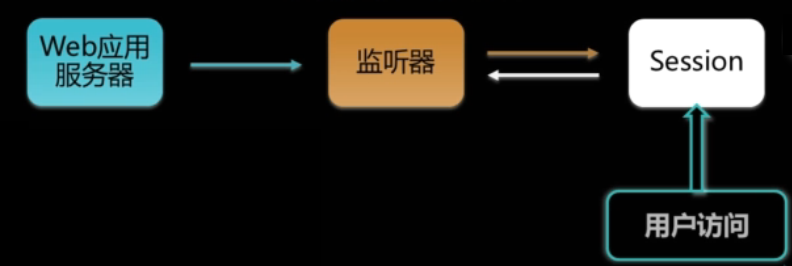1: 监听器的定义
2:监听器的用途
3:实例
4:监听器分类
5:Servlet3.0下监听器的使用
6:实际项目常用的案例
1: 监听器的定义:
监听器实际上是一个类,这个类实现了特定的接口,然后将这个类在 web.xml 文件中进行描述,这样服务器在启动的时候就可以实例化这个类,启动监听器。当范围对象的状态发生变化的时候,服务器自动调用监听器对象中的方法。例如统计用户在线人数。


web监听器是Servlet规范中定义的一种特殊类,用于监听ServletContext,HttpSession,ServletRequest等域对象的创建、销毁、以及属性的变化等,可以在事件发生前、发生后进行一些处理。
2、监听器的用途
- 1、统计在线人数和在线用户
- 2、系统加载时进行信息的初始化工作
- 3、统计网站的访问量
- 4、跟Spring结合
3、实例
在web.xml文件中进行配置

listenr-class中是自己定义的Listener的类路径
|
1
2
3
4
5
6
7
8
9
|
public class MyRequestListener implements ServletContextListener{ public void contextInitialized(ServletContextEvent event){ System.out.println("启动监听器"); } public void contextDestroy(ServletContextEvent event){ System.out.println("结束监听器"); }} |
编译器会为我们自动生成contextInitialized和contextDestroy两个函数
监听器>过滤器>serlvet,在 web.xml 文件中配置的时候注意顺序
4 监听器的分类
按监听的对象划分,可以分为监听
- ServletContext对象
- HttpSession对象
- ServletRequest对象
按监听的事件划分
- 域对象自身的创建和销毁
- 域对象中属性的创建和消除
- 绑定到session中的某个对象的状态
由于很多监听的方式一致,因此我们只考虑其中的HttpSession对象:
在web.xml中配置session超时
|
1
2
3
|
<session-config> <session-timeout> 30 </session-timeout></session-config> |
当超过30秒后,session会自动过期
|
1
2
3
4
5
6
7
8
9
|
public class MyRequestListener implements HttpSessionListener{ public void sessionCreate(HttpSessionEvent event){ System.out.println("event 创建:"); } public void sessionDestroy(HttpSessionEvent event){ System.out.println("event 销毁:"); }} |
另外,我们可以实现HttpSessionAttributeListener来实现session对象属性的增加(added)、删除(removed)、替换(replaced)的功能
|
1
2
3
4
5
6
7
8
9
10
11
12
13
|
public class MyRequestListener implements HttpSessionAttributeListener{ public void attributeAdded(HttpSessionBindEvent event){ } public void attributeRemoved(HttpSessionBindEvent event){ } public void attributeReplaced(HttpSessionBindEvent event){ }} |
5、Servlte3.0下的使用
在Servlet3.0下通过注解@WebListener("")就可以实现了,不需要在web.xml中进行配置
6、实战
|
1
2
3
4
5
6
7
8
9
10
11
12
13
14
15
16
17
18
19
20
21
22
23
24
25
26
27
28
29
30
31
32
33
34
|
public class MyRequestListener implements HttpSessionListener{ private int counts = 0;//用于统计在线人数 public void sessionCreate(HttpSessionEvent event){ counts++; event.getSession().getServletContext.setAttribute("name",counts); //用户人数+1 } public void sessionDestroy(HttpSessionEvent event){ counts--; event.getSession().getServletContext.setAttribute("name",counts);//用户人数-1 }}@WebListenerpublic class MyRequestListener2 implements ServletRequestListener{ private ArrayList<User>list; //创建一个在线用户的列表 public void requestCreate(ServletRequestEvent event){ HttpServletRequest request = (HttpServletRequest) request.getServletContext(); String sessionId = request.getSession().getSessionId(); if(sessionId ...){ .... list.add(...); } } public void requestDestroy(ServletRequestEvent event){ }}public class User{ private int sessionId; } |
注意,以上代码只是大致的代码,并不全面和正确。